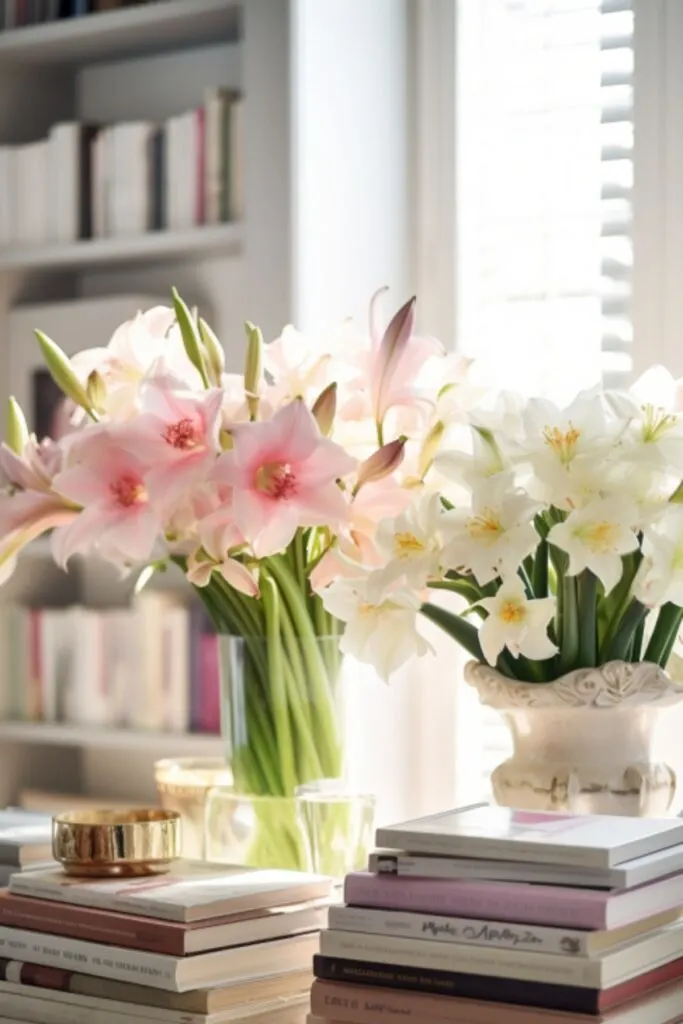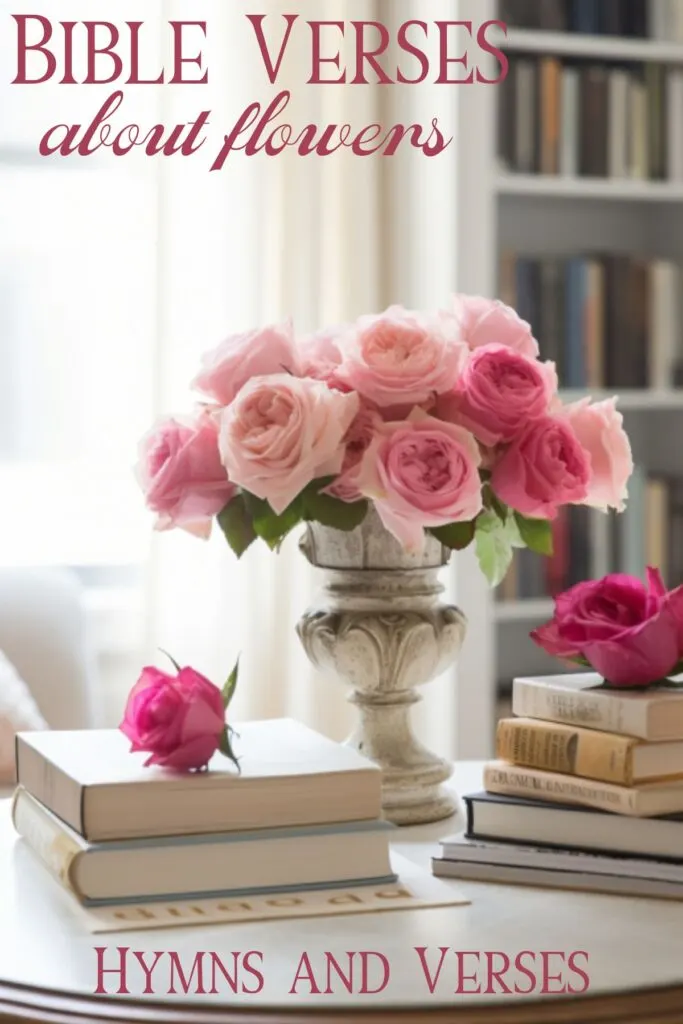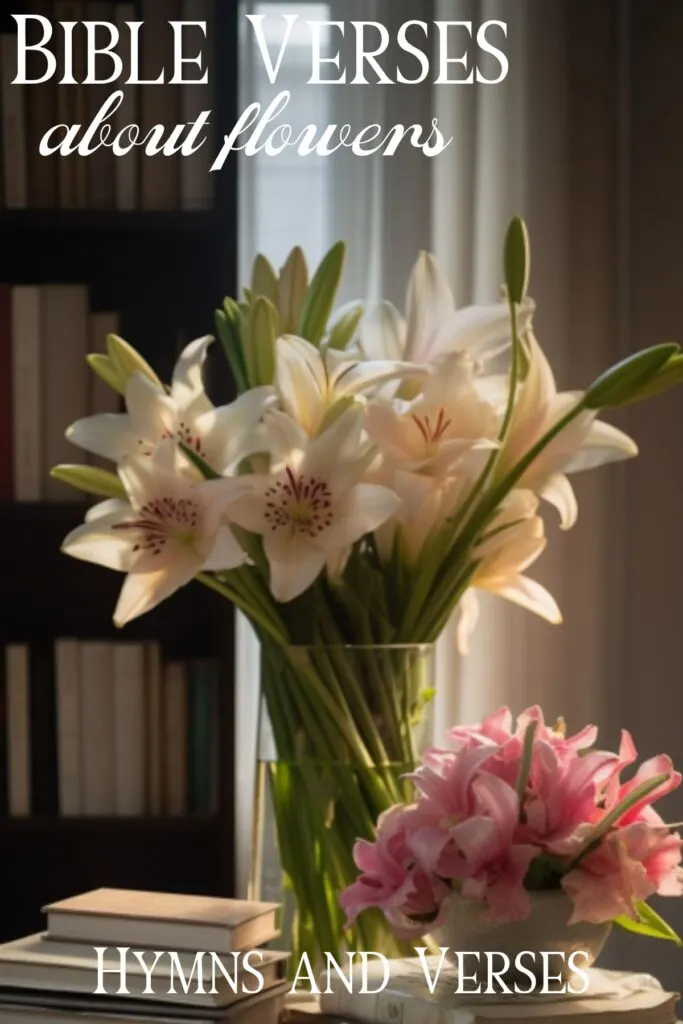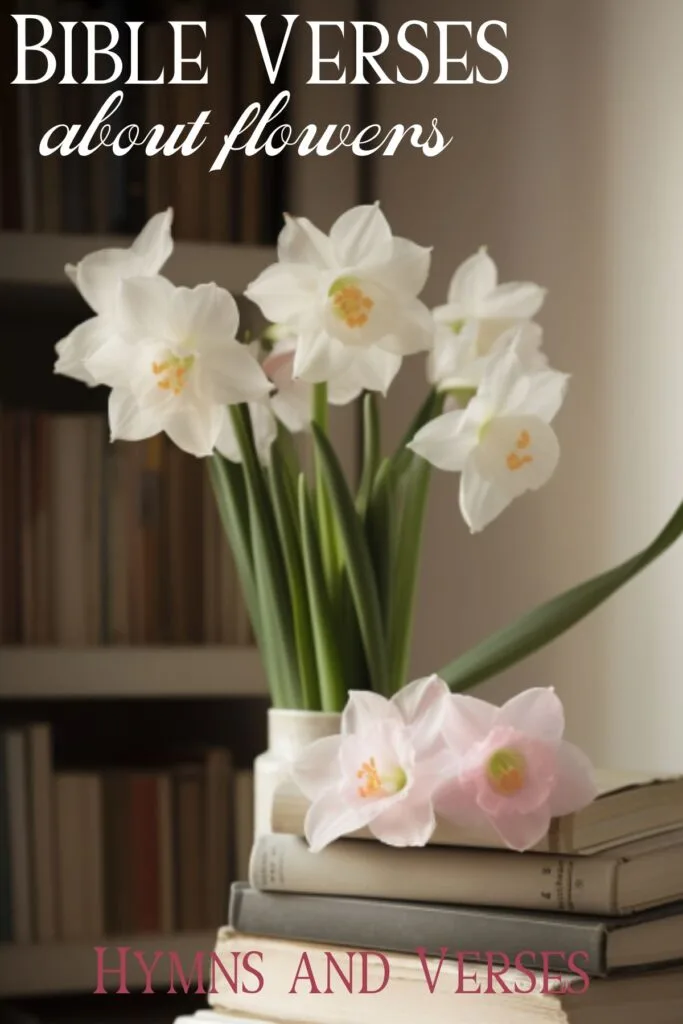Flowers have been used throughout history to convey deeper meanings and messages, and the Bible is no exception. From the lilies of the field to the roses of Sharon, flowers are mentioned throughout the Bible as a way of conveying important truths and values.
In this post, we’ll take a closer look at some of the most significant flowers mentioned in the Bible, and explore their symbolic meanings and significance. Whether you’re a lover of flowers or simply interested in the spiritual symbolism they hold, we hope you’ll enjoy this exploration of the beauty and meaning of flowers in the Bible.

What does a flower symbolize in the Bible?
Flowers are mentioned in various parts of the Bible and can symbolize different things depending on the context. Here are a few possible symbolic meanings of flowers in the Bible:
Beauty and Splendor – Flowers are often used to describe things that are beautiful and splendid. For example, the Song of Solomon uses the imagery of flowers to describe the beauty of the beloved, saying, “I am a rose of Sharon, a lily of the valleys” (Song of Solomon 2:1).
Transience – Flowers are also often used to symbolize the fleeting nature of human life. Isaiah 40:6-8 compares people to grass that withers and flowers that fade away, emphasizing the temporary nature of earthly existence.
Renewal and Growth – In some cases, flowers can symbolize renewal and growth. Isaiah 35:1-2 describes a time when the wilderness will “burst into bloom” like a crocus, suggesting a time of transformation and renewal.
Fragility – Some flowers, like lilies, are delicate and easily damaged or destroyed. This can symbolize the fragility of human life, or the need to handle things with care and delicacy.
Gift and Blessing – Flowers can also be seen as a gift or blessing from God. In Matthew 6:28-30, Jesus uses the example of the flowers of the field to teach his followers not to worry about material things, but to trust in God’s provision. The flowers are seen as a gift from God that requires no effort on our part.

Bible Verses About Flowers
Here are some beautiful bible verses bout flowers, and what they mean.
Song of Solomon 2:1 – “I am a rose of Sharon, a lily of the valleys.” In this verse, the speaker is using the beauty of the rose and lily to describe their own beauty.
Psalm 103:15-16 – “The life of mortals is like grass, they flourish like a flower of the field; the wind blows over it and it is gone, and its place remembers it no more.” This verse uses the imagery of a flower to describe the fleeting nature of human life.
Isaiah 40:6-8 – “All people are like grass, and all their faithfulness is like the flowers of the field. The grass withers and the flowers fall, because the breath of the Lord blows on them. Surely the people are grass. The grass withers and the flowers fall, but the word of our God endures forever.” This verse uses the image of flowers to reinforce the idea that human life is temporary, but God’s word is eternal.
Matthew 6:28-30 – “And why do you worry about clothes? See how the flowers of the field grow. They do not labor or spin. Yet I tell you that not even Solomon in all his splendor was dressed like one of these. If that is how God clothes the grass of the field, which is here today and tomorrow is thrown into the fire, will he not much more clothe you—you of little faith?” In this passage, Jesus uses the example of the flowers of the field to teach his followers not to worry about material things, but to trust in God’s provision.
James 1:10-11 – “But the rich should take pride in their humiliation—since they will pass away like a wild flower. For the sun rises with scorching heat and withers the plant; its blossom falls and its beauty is destroyed. In the same way, the rich will fade away even while they go about their business.” This verse uses the image of a flower to warn the wealthy that their wealth and status are temporary, and that they should not put their trust in material things.
Song of Solomon 2:12 – “Flowers appear on the earth; the season of singing has come, the cooing of doves is heard in our land.” In this verse, the speaker is describing the arrival of spring and the blooming of flowers as a time of joy and celebration.
Isaiah 35:1-2 – “The desert and the parched land will be glad; the wilderness will rejoice and blossom. Like the crocus, it will burst into bloom; it will rejoice greatly and shout for joy.” This verse uses the image of flowers to describe the transformation that will occur in the land when God comes to save his people.
Hosea 14:5-6 – “I will be like the dew to Israel; he will blossom like a lily. Like a cedar of Lebanon he will send down his roots; his young shoots will grow. His splendor will be like an olive tree, his fragrance like a cedar of Lebanon.” This verse uses the image of flowers and trees to describe the blessings that God will bestow upon his people when they turn back to him.
Matthew 13:3-8 – “Then he told them many things in parables, saying: ‘A farmer went out to sow his seed. As he was scattering the seed, some fell along the path, and the birds came and ate it up. Some fell on rocky places, where it did not have much soil. It sprang up quickly, because the soil was shallow. But when the sun came up, the plants were scorched, and they withered because they had no root. Other seed fell among thorns, which grew up and choked the plants. Still other seed fell on good soil, where it produced a crop—a hundred, sixty or thirty times what was sown.'” This parable uses the image of seeds growing into plants and flowers to describe the different ways in which people respond to the message of the Gospel.
Revelation 22:1-2 – “Then the angel showed me the river of the water of life, as clear as crystal, flowing from the throne of God and of the Lamb down the middle of the great street of the city. On each side of the river stood the tree of life, bearing twelve crops of fruit, yielding its fruit every month. And the leaves of the tree are for the healing of the nations.” This verse uses the image of trees bearing fruit and leaves for healing to describe the blessings that will be available to God’s people in the New Jerusalem.
Exodus 25:31-33 – “Make a lampstand of pure gold. Hammer out its base and shaft, and make its flowerlike cups, buds and blossoms of one piece with them. Six branches are to extend from the sides of the lampstand—three on one side and three on the other.” This verse uses the image of flower-like cups, buds, and blossoms to describe the decoration on the lampstand that was to be made for the tabernacle.
Psalm 92:12-14 – “The righteous will flourish like a palm tree, they will grow like a cedar of Lebanon; planted in the house of the Lord, they will flourish in the courts of our God. They will still bear fruit in old age, they will stay fresh and green.” This verse uses the image of trees, including the palm tree and cedar of Lebanon, to describe the flourishing of the righteous in the presence of God.
Isaiah 61:10 – “I delight greatly in the Lord; my soul rejoices in my God. For he has clothed me with garments of salvation and arrayed me in a robe of his righteousness, as a bridegroom adorns his head like a priest, and as a bride adorns herself with her jewels.” This verse uses the image of clothing and adornment to describe the blessings that God has given to his people.
Ezekiel 17:22-23 – “This is what the Sovereign Lord says: I myself will take a shoot from the very top of a cedar and plant it; I will break off a tender sprig from its topmost shoots and plant it on a high and lofty mountain. On the mountain heights of Israel I will plant it; it will produce branches and bear fruit and become a splendid cedar. Birds of every kind will nest in it; they will find shelter in the shade of its branches.” This verse uses the image of a cedar tree to describe the restoration and flourishing of the nation of Israel under God’s care.
Matthew 7:16-20 – “By their fruit you will recognize them. Do people pick grapes from thornbushes, or figs from thistles? Likewise, every good tree bears good fruit, but a bad tree bears bad fruit. A good tree cannot bear bad fruit, and a bad tree cannot bear good fruit. Every tree that does not bear good fruit is cut down and thrown into the fire. Thus, by their fruit you will recognize them.” This passage uses the image of fruit trees to teach about the importance of discernment in recognizing true followers of Jesus.
Song of Solomon 4:13-14 – “Your plants are an orchard of pomegranates with choice fruits, with henna and nard, nard and saffron, calamus and cinnamon, with every kind of incense tree, with myrrh and aloes and all the finest spices.” This verse uses the image of a garden full of fragrant and beautiful plants to describe the beauty of the speaker’s beloved.
Isaiah 40:7-8 – “The grass withers and the flowers fall, because the breath of the Lord blows on them. Surely the people are grass. The grass withers and the flowers fall, but the word of our God endures forever.” This verse uses the image of flowers and grass to emphasize the temporary nature of human life, and the enduring nature of God’s word.
Luke 12:27-28 – “Consider how the wild flowers grow. They do not labor or spin. Yet I tell you, not even Solomon in all his splendor was dressed like one of these. If that is how God clothes the grass of the field, which is here today, and tomorrow is thrown into the fire, how much more will he clothe you—you of little faith!” This passage uses the image of wild flowers to teach about the importance of trusting in God’s provision, rather than worrying about material things.
James 1:12 – “Blessed is the one who perseveres under trial because, having stood the test, that person will receive the crown of life that the Lord has promised to those who love him.” This verse uses the image of a crown to describe the reward that awaits those who remain faithful in the face of trials and adversity.
Revelation 2:7 – “Whoever has ears, let them hear what the Spirit says to the churches. To the one who is victorious, I will give the right to eat from the tree of life, which is in the paradise of God.” This verse uses the image of a tree of life to describe the reward that awaits those who remain faithful to Jesus, and the eternal life that they will receive.

What is Peter 1:23-24?
“For you have been born again, not of perishable seed, but of imperishable, through the living and enduring word of God. For, ‘All people are like grass, and all their glory is like the flowers of the field; the grass withers and the flowers fall.'”
In this passage, the apostle Peter is using the imagery of grass and flowers to emphasize the temporary nature of human life and the lasting nature of God’s word. He tells his readers that they have been born again, not through perishable seed, but through the living and enduring word of God. Then he quotes from Isaiah 40:6-8, which uses the image of grass and flowers to describe the fleeting nature of human life and the enduring nature of God’s word.
The point that Peter is making is that while human life is temporary, God’s word is eternal and enduring. The image of flowers, which are beautiful but short-lived, serves to emphasize the impermanence of human life and the need to seek eternal truths. By contrast, the word of God is living and enduring, offering a path to eternal life and meaning.
What is Isaiah 58 11?
“The Lord will guide you always; he will satisfy your needs in a sun-scorched land and will strengthen your frame. You will be like a well-watered garden, like a spring whose waters never fail.”
This verse comes from a passage in which the prophet Isaiah is calling on the people of Israel to repent and turn back to God. In this particular verse, Isaiah is offering reassurance to those who heed his call and return to the Lord. He tells them that God will guide them always and satisfy their needs, even in difficult times. The image of a sun-scorched land suggests a place of hardship and scarcity, but Isaiah promises that God’s provision will be sufficient to sustain them.
Isaiah goes on to use the imagery of a well-watered garden and a never-failing spring to describe the abundance that God will provide to those who trust in him. This image suggests not only material abundance, but also spiritual nourishment and growth. Overall, the verse conveys a sense of hope and promise for those who turn back to God and seek his guidance and provision.

Flowers in the Bible
As you can see there are many mentions of flowers in the Bible, and a great deal of symbolism that goes along with it. Let’s take a look at some more examples.
Lily – Often associated with beauty and purity, the white lily is mentioned in Song of Solomon and in the teachings of Jesus as an example of God’s provision.
Rose – A symbol of love and beauty, the rose is sometimes associated with Jesus as the embodiment of divine love. The rose of Sharon, mentioned in Song of Solomon, may be a type of crocus or hibiscus, rather than a true rose.
Hyssop – A type of herb used for purification and cleansing, hyssop is mentioned in the Old and New Testaments.
Myrtle – A fragrant shrub mentioned in Isaiah and Nehemiah, the myrtle symbolizes prosperity and abundance.
Narcissus – A fragrant flower mentioned in the Song of Solomon, the narcissus symbolizes sweetness and beauty.
Pomegranate – While not technically a flower, the pomegranate is mentioned in the Bible as a symbol of fertility, abundance, and blessing.
Olive – While not a flower either, the olive tree and its branches are mentioned frequently in the Bible as a symbol of peace, prosperity, and the blessings of God.
Crocus – A beautiful and fragrant flower mentioned in Isaiah, the crocus is a symbol of hope and renewal.
Almond Blossom – Mentioned in Exodus and Numbers, the almond blossom is a symbol of God’s watchful care and the fulfillment of his promises.
Anemone – A delicate and colorful flower mentioned in the Song of Solomon, the anemone symbolizes fleeting beauty and the transience of human life.
Balsam – A fragrant plant mentioned in the Old and New Testaments, balsam is associated with healing and restoration.
Camphire (Henna) – A flowering plant mentioned in Song of Solomon, camphire is a symbol of beauty and love.
Cedar – A majestic tree mentioned throughout the Old Testament, the cedar symbolizes strength, durability, and the blessings of God.
Cinnamon – A fragrant spice mentioned in the Song of Solomon and other books, cinnamon is associated with beauty, luxury, and prosperity.
Frankincense – A fragrant resin used in ancient times as a symbol of worship and devotion, frankincense is mentioned in the Old and New Testaments as a symbol of prayer and offering.
Hyacinth – A fragrant flower mentioned in the Song of Solomon, the hyacinth symbolizes grace and beauty.
Mandrake – A plant with fragrant flowers mentioned in the Song of Solomon and Genesis, the mandrake symbolizes fertility and love.

What did Jesus say about the wild flowers?
In the Bible, Jesus speaks about wild flowers in Matthew 6:28-30, which says:
“And why do you worry about clothes? See how the flowers of the field grow. They do not labor or spin. Yet I tell you that not even Solomon in all his splendor was dressed like one of these. If that is how God clothes the grass of the field, which is here today and tomorrow is thrown into the fire, will he not much more clothe you—you of little faith?”
In this passage, Jesus uses the example of wild flowers to teach his followers not to worry about material things, such as clothing. He points out that the flowers of the field do not labor or spin to make their own clothing, yet they are beautifully clothed by God. He then reminds his followers that they are much more valuable than the wild flowers, and therefore should trust in God’s provision for their needs.
The passage emphasizes the importance of faith in God’s provision and the idea that worrying about material possessions is unnecessary. Jesus uses the image of wild flowers to emphasize the beauty and value of God’s creation, and to encourage his followers to trust in God’s care for them.

What do lilies symbolize in the Bible?
In the Bible, lilies are used symbolically to represent various things, including beauty, purity, and abundance. Here are a few examples:
Beauty – In the Song of Solomon, the beloved is compared to a lily, which is a symbol of beauty and grace. The passage says, “I am a rose of Sharon, a lily of the valleys” (Song of Solomon 2:1).
Purity – The white color of the lily is often seen as a symbol of purity and innocence. In Matthew 6:28-29, Jesus uses the image of lilies to illustrate God’s provision for his people, saying, “See how the lilies of the field grow. They do not labor or spin. Yet I tell you that not even Solomon in all his splendor was dressed like one of these.”
Abundance – Lilies are often associated with abundance and prosperity in the Bible. In Luke 12:27-28, Jesus uses the example of the lilies of the field to teach his followers not to worry about material possessions, but to trust in God’s provision. The passage says, “Consider how the wild flowers grow. They do not labor or spin. Yet I tell you, not even Solomon in all his splendor was dressed like one of these. If that is how God clothes the grass of the field, which is here today, and tomorrow is thrown into the fire, how much more will he clothe you—you of little faith!”
Overall, lilies are used symbolically in the Bible to represent various positive qualities, including beauty, purity, and abundance.
Exploring the symbolism of flowers in the Bible can be like unwrapping a beautiful bouquet of flowers. From the lilies of the field to the roses of Sharon, each flower carries its own unique meaning and significance, reflecting the beauty and complexity of God’s creation.
As we’ve seen, different flowers are often used to represent different themes and values in the Bible, such as purity, beauty, and abundance. Understanding the symbolism of flowers in the Bible can help deepen our appreciation for the richness of scripture and the power of nature to convey deeper truths.
Whether you’re a lover of flowers or simply interested in the spiritual symbolism they hold, we hope you’ve enjoyed this exploration of the beauty and meaning of flowers in the Bible. Just as a bouquet of flowers can brighten up a room, so too can the symbolic language of flowers in the Bible brighten up our understanding and appreciation of scripture.
Looking to learn more about what things symbolize in the Bible? Take a look at sparrows in the Bible too.